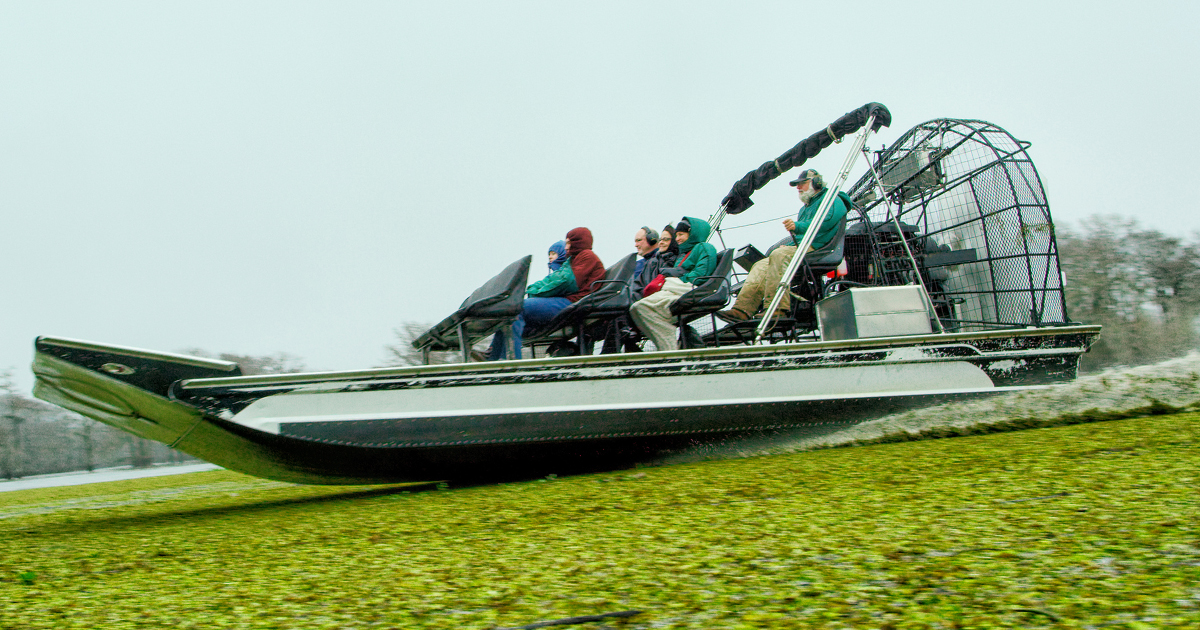
July 17, 2024 – A wetter-than-normal spring has raised water levels on lakes and rivers throughout Wisconsin.
More water means more recreational opportunities for boaters, water skiers, and anglers. But a recent ruling by the Jefferson County Circuit Court calls into question longstanding principles underlying the right of boaters and others to use the state’s navigable waterways in certain situations.
Airboat Escapades
Farmland owned by Thomas Reiss in the Town of Ixonia in Jefferson County lies along the Rock River.
The land doesn’t usually have any standing water. However, occasionally the river swells and sends standing water onto Reiss’s land. The standing water sits above the river’s ordinary high-water mark (OHWM).
According to a complaint filed by Reiss in Jefferson County Circuit Court in July 2023, boaters using air boats – flat-bottomed boats with large, fan-bladed motors mounted atop the stern – crossed over the standing water on Reiss’s land.
Airboats can skim over very shallow water because their motors aren’t submerged; they can even skim over land for significant distances.
Reiss claimed that he asked the Jefferson County Sheriff’s Office to issue citations to the air boaters, to no avail.
Lawsuit Follows
In his lawsuit, Reiss asked the circuit court to declare that the Department of Natural Resources’ “wet feet” rule, a guidance document that allows the public to use any portion of a navigable waterway as long as they’re able to keep their feet wet while doing so, violates the Wisconsin constitution and state statutes.
 Jeff M. Brown, Willamette Univ. School of Law 1997, is a legal writer for the State Bar of Wisconsin, Madison. He can be reached by email or by phone at (608) 250-6126.
Jeff M. Brown, Willamette Univ. School of Law 1997, is a legal writer for the State Bar of Wisconsin, Madison. He can be reached by email or by phone at (608) 250-6126.
Reiss argued that the “wet feet” rule violates the public trust doctrine because the rule extends public access to private wetlands above the OWHM of a navigable waterway.
Under the public trust doctrine, the Wisconsin Legislature and the Department of Natural Resources (DNR) carry out Article IX, Section 1 of the state constitution, which states that certain waters “shall be common highways and forever free,” [to the public], “without any tax, impost or duty therefor.”
The Wisconsin Supreme Court, in
Rock-Koshkonong Lake Dist. v. DNR, 2013 WI 74, 350 Wis. 2d 45, 833 N.W.2d 800, ruled that the DNR’s authority under the public trust doctrine ends at the limits of a waterway’s OHWM.
Consequently, Reiss argued, the DNR’s “wet feet” rule, which in some cases allows users to traverse waters above a waterways’ OHWM, is invalid.
Reiss also argued that in issuing the guidance document that establishes the “wet feet” rule, the DNR exceeded its authority under
Wis. Stat. section 30.10.
That statute reiterates the DNR’s authority to implement and enforce the public trust doctrine to navigable lakes, streams, sloughs, bayous, and marsh outlets. Reiss argued that flooded farmland fits into none of those categories.
Reiss also argued that the guidance setting forth the “wet feet” rule was an unpromulgated administrative rule that violated
section 227.40(4)(a).
Court Invalidates ‘Wet Feet’ Rule
On June 24, 2024, the circuit court ruled in Reiss’s favor. The court issued an oral ruling from the bench but hasn’t issued a written decision yet.
According to
Reiss’s attorneys, Jefferson County Circuit Court Judge Bennett J. Brantmeier invalidated the DNR’s “wet feet” rule, and concluded that the rule misinformed the public by saying it could use navigable waterways above the OHWM.
Brantmeier ruled that he plans to enter a permanent injunction against the DNR – one that will require it to rescind or correct the guidance establishing the “wet feet” rule.
As of the date of this article, the DNR has not appealed the case.
Navigational Servitude

“The common understanding before this case was the DNR’s ‘wet feet’ rule. That’s what we’ve used for a long time.” – Larry Konopacki, Stafford Rosenbaum LLP
Larry Konopacki, a partner at Stafford Rosenbaum LLP, said that Judge Brantmeier’s decision – if it sticks – will upend part of water law in Wisconsin.
“The common understanding before this case was the DNR’s ‘wet feet’ rule,” Konopacki said. “That’s what we’ve used for a long time.”
Konopacki, who’s practiced water law for 19 years, said disputes over the use of navigable waterways are common.
Konopacki said the public trust doctrine and the “wet feet” rule aren’t the only sources of authority at play. There’s also the navigational servitude that attaches to any submerged land held in fee, like Reiss’s farmland.
According to Konopacki, Wisconsin caselaw holds that navigational servitude means the public has the right to use the water above land held in fee in ways that are incidental to navigation, such as boating, walking on the bottom, fishing – even sinking a boat anchor. But uses that aren’t incidental to navigation – say, building a duck blind – aren’t subject to the servitude.
Konopacki often gets calls from landowners upset about boaters using airboats and mud boats to traverse submerged property. Mud boats use motors that float atop shallow water and can churn through muddy or sandy bottoms.
Konopacki said he advises clients that the use of mud boats goes beyond the navigational servitude their submerged lands are subject to, while the use of kayaks and canoes falls inside the bounds of the servitude.
“If the water’s not deep enough to navigate across, say, a sandbar to get into a back slough … if you’re creating a channel, I’ve always said that’s illegal,” Konopacki said.
“That’s affecting someone’s underlying private land in a way that’s impermissible. But if you can keep your feet wet and get out and pull your canoe or small boat through a couple of inches of water to get to where you’re going, then it’s always been the general understanding that that’s acceptable.”
Konopacki said he’ll be keeping an eye on the Jefferson County case if it's appealed.
“I’m interested to see if we’ve been reading previous caselaw that underlies the wet feet rule too broadly and making some assumptions about the intent of those cases,” Konopacki said.
‘Holy Grail’

“I don’t think it’s surprising that public rights only apply to an area beneath the ordinary high-water mark.” – Art Harrington, Godfrey & Kahn
Art Harrington, a shareholder at Godfrey & Kahn in Milwaukee, said he wasn’t surprised that the “wet feet” rule was established in a guidance document instead of a rule promulgated through the notice-and-comment process.
“[The ruling] is an unremarkable result where you’re invalidating guidance that’s of general application, while chapter 227 makes it very clear that the DNR needs to go through rulemaking, it can’t just rely on guidance.”
Harrington, who represented the Rock-Koshkonong Lake District in the
Rock-Koshkonong Lake District v. DNR, said he wasn’t surprised by Judge Brantmeier’s handling of the public trust doctrine.
“I don’t think it’s surprising that public rights only apply to an area beneath the ordinary high-water mark,” Harrington said.
According to Harrington, the DNR takes its obligations under the public trust doctrine very seriously.
“I think the public trust doctrine is like a holy grail, not only to the DNR, but to third parties,” Harrington said.
‘There Has to Be a Balance’
Whether the DNR appeals the Jefferson County case or not, Konopacki said that Wisconsin’s abundant waterways will continue to sprout lawsuits.
“Where the people are, water resources will be used and, in many cases, altered,” Konopacki said. “We’re always wrestling with new things under the public trust doctrine.”
For instance, Konopacki said it will be interesting to see if the DNR relies on the public trust doctrine to regulate wake boats. Wake boats are long boats with deep V hulls that use large inboard motors and hull technology to create big wakes alongside the boat, the better to wakeboard with.
Environmental groups say that the use of wake boats on smaller, shallower lakes harms and degrades water quality and scours lake bottoms.
“We need to be looking it as a living doctrine,” Konopacki said. “My take is that the public trust doctrine does not allow you to do whatever you want, resource be damned, but I do think there has to be a balance.”
“I don’t think you ban wake boats completely. I don’t think the public trust doctrine prevents us from doing that balancing.”
Learn more about legislative changes, regulatory issues, and recent case law with the 36th Annual Environmental Law Update from State Bar of Wisconsin PINNACLE®.
This 7.0 CLE, 1.0 EPR program takes place in person Thursday, Sept. 12, 2024, 8:15 a.m. to 4:30 p.m. at the State Bar Center in Madison; and via webcast on specific dates September through December. Visit WisBar's Marketplace for more information and to reserve your spot.
